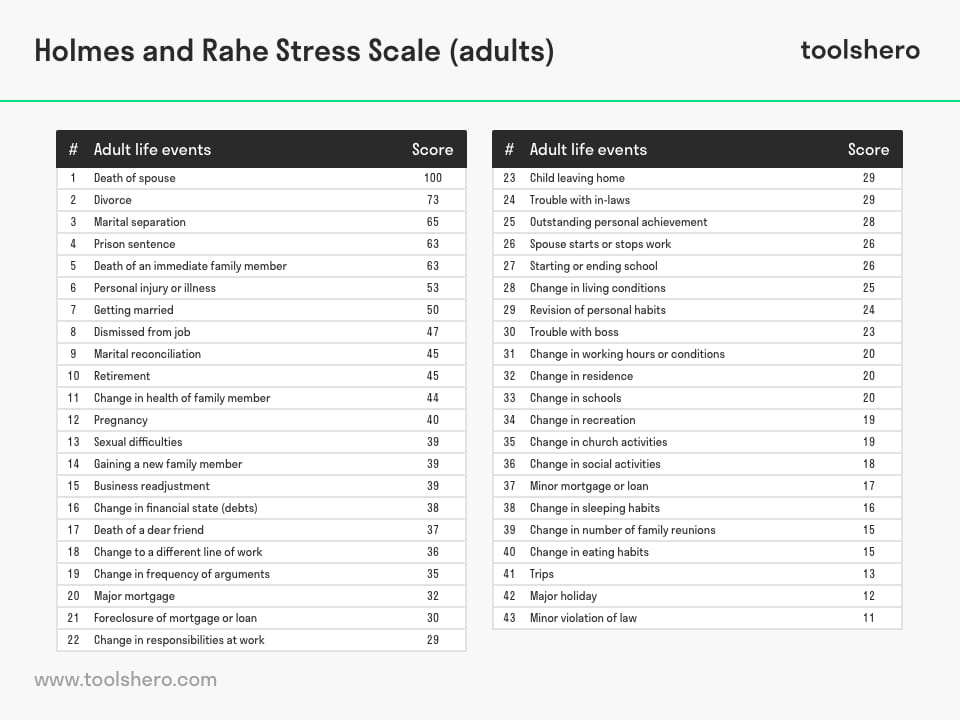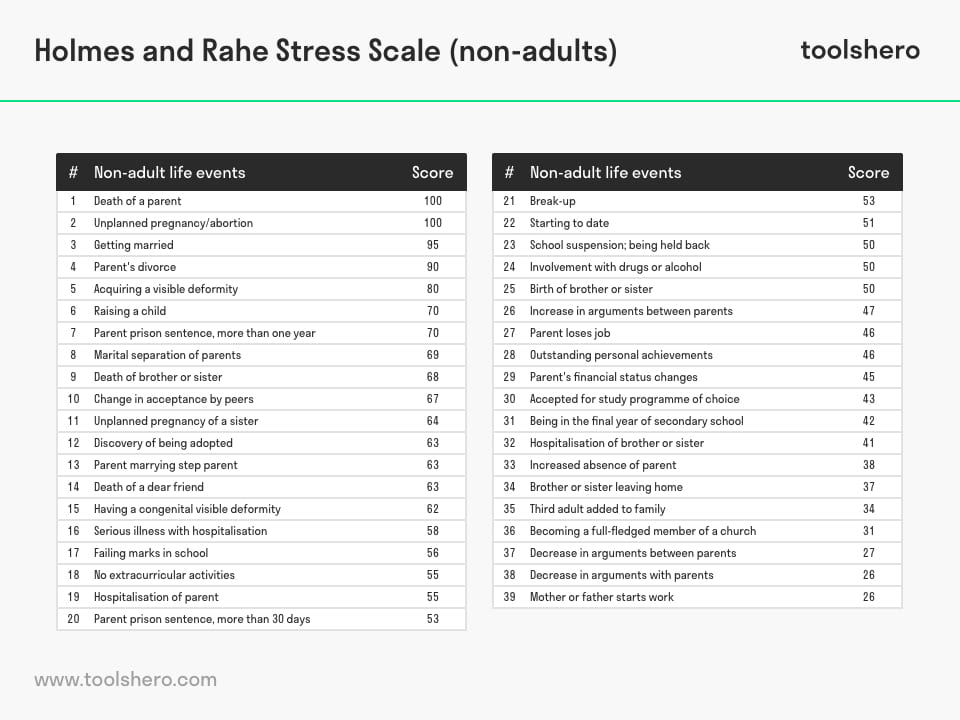Holmes and Rahe Stress Scale: Theory and Test

Holmes and Rahe Stress Scale: this article describes the Holmes and Rahe Stress Scale, developed by Thomas Holmes and Richard Rahe in a practical way. Next to what it is (definition), this article also highlights the impact, that the test is also for non-adults, the effects of long term stress, taking measures and a downloadable Holmes and Rahe Stress Scale test to get started. After reading you will understand the basics of this stress management analysis tool. Enjoy reading!
What is the Holmes and Rahe Stress Scale?
In the 1970s, American psychiatrists Thomas Holmes and Richard Rahe came up with a scale for measuring stress levels.
The Holmes and Rahe Stress Scale test helps us to understand the impact of long-term stress.
The scale consists of a list of 43 stressful life events a person can experience, which may lead to illness and health breakdown.
Definition of the Holmes and Rahe Stress Scale
In 1967, Thomas Holmes and Richard Rahe studied the medical records of over 5,000 cross culturally patients. They wanted to determine to what extent such stressful experiences might have led to their illnesses.
With their research, Holmes and Rahe showed a positive correlation between their life events and illness. The results were published as the Social Readjustment Rating Scale (SRRS), that would later gain prominence as the Holmes and Rahe Stress Scale.
List
Below follows a list of the most impactful life events that an adult person can experience and which cause stress. Each event is called a Life Change Unit (LCU) and has a different ‘weight’ in terms of stress.
The more events the person accumulates, the higher the score and chances of illness. Next to the life event (LCU), the score is listed that should be counted if this event applies. If the life event does not apply, no score will be filled in. The score is a rough estimate of how stress can influence a person’s health.
The Holmes and Rahe Stress Scale then adds the total score. If a score is between 300 and 600, there’s a significant to very significant risk of developing an illness in the near future.
Note: a score 300 or more as an 80% chance of health breakdown within short time. A score between 150 and 299 indicates a moderate to significant risk of illness in the near future, and people with a score below 150 are least at risk.

Figure 1 – Holmes and Rahe Stress Scale for adults
Non-adults
Holmes and Rahe also developed an adjusted scale for non-adults with a total of 39 life events. The final score is the same as the adult test.

Figure 1 – Holmes and Rahe Stress Scale for non-adults
Holmes and Rahe Stress Scale : Impact
Both the lists for adults and for non-adults show various LCUs that have a major impact on a person’s life. Now we’ll discuss some of these LCUs in more detail. Particularly the death of a spouse and divorce leave their marks on people.
This is mainly due to the connection that people have had for years that suddenly ends. A prison sentence for themselves or family member also falls into that category. The death of an immediate family member brings a sense of loss as well as sadness.
That has to be processed. Furthermore, the way the family member died determines the level of stress this involves. For instance, a fatal accident is different from a progressive disease.
Additionally, getting married and being fired are considered high-impact LCUs. In the case of getting married, matters such as preparation, future in-laws, and meeting your partner’s expectation play a major role. Getting fired means losing one’s daily routine as well as feelings of shame.
Both the LCUs above as those for non-adults almost exclusively relate to changes in home life and / or family composition. That’s why the death of a parent tops the list for non-adults, followed by unplanned, teenage pregnancy, possibly resulting in abortion.
Just like being fired, shame is a major factor there as well. Parents getting divorced is another high-impact event for children and adolescents.
It’s often accompanied by feelings of guilt and the pain of having to choose between parents. Studies have shown that children of divorced parents experienced the arguments preceding the divorce as less stressful than the divorce itself.
A parent going to prison can also play a major role. Note that the list indicates a prison sentence of over a year. That likely has to do with the major change to home life. For shorter sentences, it’s more like a parent having left for a business trip.
The longer the parent is away, the bigger the impact. Another major impact results from the death of a brother or sister. Don’t underestimate the effect poor school performance can have.
This is often accompanied by reduced acceptance from peers. When they’re not doing well in school and when children or adolescents aren’t socially accepted, it can even lead to a suicide attempt.
The effects of long-term stress
Stress is an abstract concept. Formally, people experience it when they sense that things are beyond their control.
It also occurs when things are imposed by others, or if the people around them have expectations that are high. Take the use of social media for instance, which makes people feel obligated to be part of the flow and respond to what they see.
The ability to meet the demands that are put on them is, is the key to stress. Both a lot of simultaneous stress situations and long exposure to a single stressful situation can lead to a negative experience of it.
If someone has been in debt for three years, they will experience more stress than someone who is moving house, expecting a child, and changing jobs.
And not all unusual events are equally difficult to handle. The stress of divorce is of an entirely different magnitude than being given more responsibility of work. It’s therefore very important in SRRS to measure and assess the total stress score in the right way. Only then can it actually be used to manage it better.
Stress Management: 40+ easy ways to deal with stress
Stress relief and burnout prevention. Don’t let stress control your life. Beat anxiety and worries. Live, Laugh, Love.
Taking measures
If it turns out there’s an increased risk of stress, it’s a good idea to do something about it. That’s not always easy though. Still, becoming aware of it’s factors is an important first step to eliminate these.
Events like a move or imminent retirement are usually unavoidable. Situations like arguments causing problems, however, can be mitigated through training, for instance.
Holmes and Rahe Stress Scale test
Discover which impactful life events could bring you stress and what its possible consequences are. Get started with this ready to use Holmes and Rahe Stress Scale test.
Download the Holmes and Rahe Stress Scale test
This template is exclusively for our paying Toolshero members. Click here to see if a membership is something for you!It’s Your Turn
What do you think? What are your experiences with the Holmes and Rahe Stress Scale Test and concept? Do you think the list of major life events is complete? Do you recognize the practical explanation or do you have any additions? How do you deal with it?
Share your experience and knowledge in the comments box below.
More information
- Holmes, T. H., & Rahe, R. H. (1967). The social readjustment rating scale. Journal of psychosomatic research.
- Noone, P. A. (2017). The holmes–rahe stress inventory. Occupational Medicine, 67(7), 581-582.
- Tennant, C., & Andrews, G. (1976). A scale to measure the stress of life events. Australian and New Zealand Journal of Psychiatry, 10(1), 27-32.
How to cite this article:
Mulder, P. (2019). Holmes and Rahe Stress Scale. Retrieved [insert date] from Toolshero: https://www.toolshero.com/human-resources/holmes-and-rahe-stress-scale/
Original publication date: 11/28/2019 | Last update: 12/25/2023
Add a link to this page on your website:
<a href=”https://www.toolshero.com/human-resources/holmes-and-rahe-stress-scale/”>Toolshero: Holmes and Rahe Stress Scale</a>












